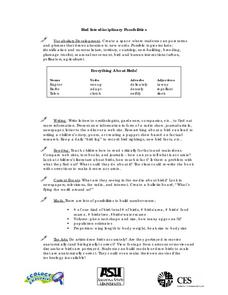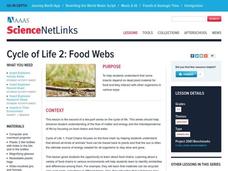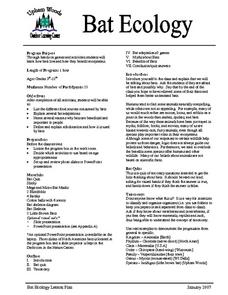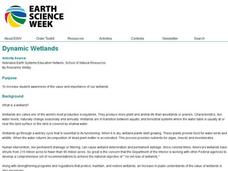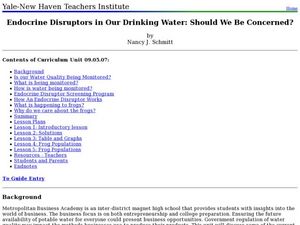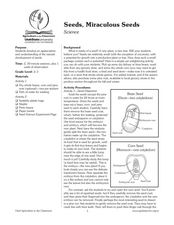Howard Hughes Medical Institute
Regulation of the Lactase Gene
All human infants are lactose tolerant, yet some adults are lactose intolerant—why is that? Individuals discover the process of gene mutation through a study of the lactase gene (LCT). They understand the geographic connections,...
Howard Hughes Medical Institute
Stickleback Evolution Virtual Lab
How quickly do animals evolve? Can comparing different samples of the same fossil answer timeline questions? Scholars use virtual labs to examine fossils and learn about stickleback evolution. They compare pelvic morphology in lakes...
Curated OER
Animals Word Search Puzzle
To make the classic word search more challenging and academic, this animal-terms puzzle has scholars solving clues to determine the words they find. Fifteen clues give detailed definitions of biology terms such as carnivore, reptile,...
Curated OER
A Matter of Survival
Fourth graders dance with inspiration from wild animals. In this creative movement lesson plan, 4th graders watch a video clip and then move like an animal might move in their natural surroundings.
ARKive
Butterflies and Blooms
The Northwoods of Wisconsin are lovely in the summer,and they are also home to many flower and butterfly species. Investigate the ways in which seasonal flowers and butterflies are interdependent on each other for survival with a fun...
Curated OER
Sheffield Island Adaptation Activity
You don't have to visit The Maritime Aquarium to use this plan, but you would need to find a location where a variety of bird species live, re-write the activity worksheet to incorporate the local species, and purchase field guides for...
Curated OER
Life on the Ocean Floor
Why would water 2700 meters deep suddenly become warmer? Explore this and other ocean floor discoveries through this reading response worksheet. Scholars read information about the organisms discovered by Alvin, a deep-sea submersible....
NorthEast Ohio Geoscience Education Outreach
Ecosystems and Change
Pairs of ecologists select an animal and investigate an ecosystem from its point of view. This simple lesson involves Internet research and putting together a presentation of collected information.
Curated OER
Bird Interdisciplinary Possibilities
Students explore birds, their territory, breeding, and seasonal movement. They research and collect information on birds through writing letters to ornithologists, reading in books, comparing web sites, and observing pictures. Students...
Curated OER
The Ocean Floor and Shore Zones
Make textbook reading more engaging using this reading activities learning exercise, through which scholars review major features found on the ocean floor and the processes that formed these features. They complete 11 terms in a...
Curated OER
Forest Communities
Students identify tree specimens. In this tree specimens instructional activity, students collect different parts of a tree from the areas around the school or their home. They then work in groups to create booklet that identifies tree...
Curated OER
Where Are the Dinosaurs?
Students examine the concept of extinction by studying dinosaurs. For this living environment lesson, students view dinosaur video clips and define the word "extinction." Students visit the "Zoom Dinosaur" website to investigate various...
Curated OER
Nutrition Dictionary Worksheet
In this vocabulary worksheet, 7th graders use words associated with nutrition. Students respond to 10 words, looking each up in the dictionary and writing one fact that they have learned about each specific word.
Curated OER
Let's Go Camping!
Middle schoolers discuss the necessities for a camping trip. In this camping simulation lesson plan, students identify what supplies to take with them on a camping trip and read the rules and regulations for campers. Middle schoolers...
Curated OER
Milk: A Practical Application
Explain the coagulation and coalescence processes associated with milk protein and cheese. List the components of milk and explain how each component is dispersed in the milk. Describe what happens when milk protein is coagulated Discuss...
Curated OER
Amino Acids
Identify the properties of proteins and amino acids. Name the groups of elements that identify an amino acid Describe the chemical structure of protein Explain what happen during the denaturation of protein and how the process occurs
Curated OER
Bat Ecology
Young scholars, through hands on games and activities, discover how bats live and how bats benefit ecosystems. They play a game designed to show them how echolocation works and another to show how mother bats locate their young through...
Curated OER
Squirrel Islands
In this adaptations worksheet, young scholars read about 3 species that have changed over time to adapt to their environment. Students design a squirrel that has adapted to an island habitat that young scholars are assigned. They...
Curated OER
Animals Vocabulary Fill Puzzle
In this science instructional activity, students figure out the answers to 15 clues going across and down associated with vertebrate animals. Students fill in a crossword puzzle.
Curated OER
Dynamic Wetlands
Students construct and observe a model of two different types of wetlands. In this wetlands lesson, students create a model of a wetland with constant drainage and a wetland that maintains a well-saturated soil. Students observe and...
Curated OER
fun with Plants that We Use
Students become familiar with the products made from various plants. In this plants lesson, students experiment with natural dyes from plants. Students complete a list of things made from plants. Students answer questions about plant...
Curated OER
Endocrine Disruptors in Our Drinking Water: Should We Be Concerned?
Young scholars investigate the different hormone contaminants in the water supply. In this math lesson, students analyze data tables and graphs. They demonstrate exponential growth and decay using frog populations.
Curated OER
Seeds, Miraculous Seed
Students investigate relationships between plants and animals and how living things change during their lives. In this life cycle lesson, students split different types of seeds apart to see the beginning life stages of future plants.
Curated OER
Cricket Wars
Students investigate crickets in their habitat. In this insect lesson, students create a cricket habitat by using a glass jar with grass clippings and cloth. Students observe how crickets interact with each other and their eating habits.










